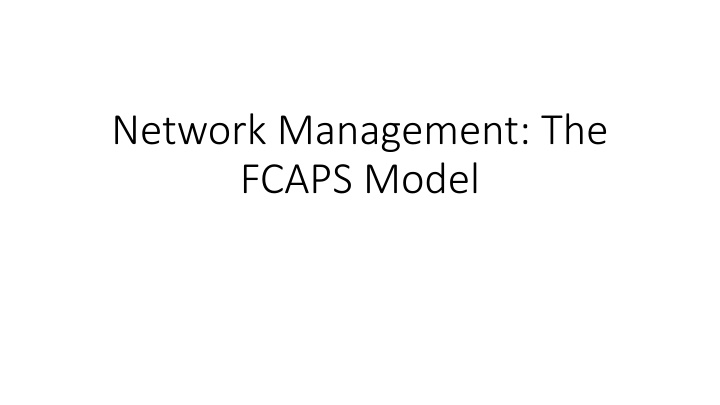
Understanding FCAPS Model in Network Management
Explore the FCAPS model for efficient network management, encompassing Fault, Configuration, Accounting, Performance, and Security aspects. Learn how this model guides network developers and operators in maintaining networked environments effectively.
Download Presentation

Please find below an Image/Link to download the presentation.
The content on the website is provided AS IS for your information and personal use only. It may not be sold, licensed, or shared on other websites without obtaining consent from the author. If you encounter any issues during the download, it is possible that the publisher has removed the file from their server.
You are allowed to download the files provided on this website for personal or commercial use, subject to the condition that they are used lawfully. All files are the property of their respective owners.
The content on the website is provided AS IS for your information and personal use only. It may not be sold, licensed, or shared on other websites without obtaining consent from the author.
E N D
Presentation Transcript
Network Management: The FCAPS Model
Managing a modern network is not an easy task. Current networks are highly connected, and multiple services depend on them to be provided. Thus, network managers and operators must attempt several maintainability aspects to keep services online and with proper quality-of-service levels.
n this context, well investigate FCAPS, a network management model. FCAPS presents five working levels for network management: Fault, Configuration, Accounting, Performance, and Security.
The FCAPS Model The FCAPS model aims to provide a guide for developers and operators on how to manage a networked environment.
1- Fault Management In a network, it is not unusual for faults happening. Faults will eventually occur, even adopting several preventive actions against them. In this way, fault management in FCAPS aims to detect these faults and mitigate their consequences, in addition to recovering the networked system.
2- Configuration Management Managing the configuration of networked systems is guaranteeing that they will work as expected in their lifecycle, even when updates, upgrades, and scaling processes happen. Configuration management deals with hardware and software:
2- Configuration Management On the hardware side, for example, we have inventory management that comprises all the machinery available for a networked system. Also, we have allocation management refereeing to the best physical placement of hardware resources and upgrading and scaling management to provide the proper amount of computational resources for the networked system. On the software side, we should attempt to find the best hardware machine for running the required programs regarding execution support and performance. Moreover, operators should manage the running software versioning, keeping it updated. Finally, configuring the system also includes defining which operators will have access to each part of it.
3. Accounting Management Accounting management aims to optimize the distribution of resources among the network clients. Thus, we can understand accounting management as administrative tasks involving network managers, operators, and clients.
3. Accounting Management A particular task of accounting management is creating an inventory of all available network resources. In this way, while routines executed in configuration management update the machinery in this inventory, the accounting management focuses on updating the inventory itself. Accounting management also works on billing management. So, to do that, operators and managers typically generate statistics on clients registers, their network usage, and the impact of different network usage profiles. Finally, it is also a task of accounting management to determine the proper permissions and access rights of each client in the network.
4. Performance Management As the name suggests, performance management works on monitoring and trying to improve the overall performance of a network. We can see performance improvements in different manners, such as maximizing throughput, minimizing latency, and avoiding bottlenecks.
4. Performance Management The central objective of performance management is improving the provided quality of service and experience for the clients. But, more than that, performance management enables the managers and operators to understand the network necessities as the number of clients grows or decreases or the service level agreements change.
5. Security Management The main idea of security management is controlling the access to the resources and equipment of a network, mainly the sensitive ones. By avoiding improper accesses and modifications in the network, the operators and managers both keep the network active and the clients secure. Examples of typical attacks that may occur in a network are denial of service, man-in-the- middle, and DNS poisoning, among others. Security management starts in the core network itself. Relevant actions to securing a network consist of deploying network functions tailored to identify and mitigate attacks. Security function examples are intrusion detection and prevention systems, firewalls, antivirus, etc.
